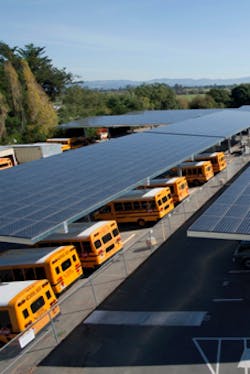Santa Barbara School District Looks at 18 Sites for Microgrids. Intends to Issue RFP
California’s rapid embrace of microgrids continued this week with a Santa Barbara school district approving feasibility studies for solar microgrids that it wants to fast track at as many as 18 sites.
The Santa Barbara Unified School District voted Monday to hire the Clean Coalition and Sage Energy Consulting to conduct the studies and handle solicitations and vendor selection for projects deemed feasible.
The deal follows release of a solicitation last week by Pacific Gas & Electric for 20 microgrids, as well as the announcement in recent weeks of an array of other microgrids being built in California in anticipation of more wildfire related power shutoffs.
The Santa Barbara microgrids would use solar plus storage and would include electric vehicle charging infrastructure. An initial analysis by the Clean Coalition identified more than 15 MW of solar potential at the schools.
The school district budgeted $519,300 for the initial work and approved $287,900 for the team to undertake the first stage — feasibility studies through the contract review. The second phase — design review through project closeout — is expected to cost another $231,400.
$40M estimate for 14 microgrids
In their proposal to the school district, the partners estimated a total project cost of about $40 million if the school district ends up building 14 microgrids.
But because the microgrids will operate under a power purchase agreement (PPA), the school district will incur no upfront capital costs, and it may may roll a large percentage of the design and project management fees into the PPA. Ultimately, the district expects to pay only for electricity delivered by the microgrids, at a rate no higher than what it would otherwise pay to the local utility, Southern California Edison.
In addition, seven of the sites are within low-income communities so may qualify for new energy storage incentives the state is expected to enact.
The Santa Barbara school district intends to extend the microgrids’ benefits to the broader community in various ways, including offering night time electric vehicle charging to those who cannot install chargers where they live, such as apartment dwellers.
“Beyond providing a foundational education, our schools offer places of refuge that are relied upon in times of need,” said Laura Capps, president of the school board, during the public meeting. “Sustainability and resilience are critical, and I am proud of the unanimous support being shown in this effort across the district’s board, superintendent, and other district leadership — and positive embrace by the broad community is greatly appreciated.”
The Clean Coalition and Sage Energy were among five companies that bid to manage the project. They won after teaming up. Other bidders were Community Action Commission in Santa Barbara, SPURR and Climatec.
“The Santa Barbara Unified School District is showing tremendous leadership in planning solar-driven microgrids and electric vehicle charging to support the community,” said Craig Lewis, executive director of the Clean Coalition. “The district is taking a major step toward a resilient electricity system for the Santa Barbara region; and as one of the most important property owners in the region, the district is providing a shining example for others to follow.”
In choosing vendors to build the microgrids, the team intends to employ a complex matrix of system design, electricity cost, energy arbitrage, and long-term financing, according to the school district.
The school district hopes to have development contracts signed by June 2020 with the intent of having the microgrids completed in 2022. “We are fast-tracking this timeline and project as we apply our due diligence every step of the project,” said a school district memo on the project.
Track news about California microgrids. Subscribe to the free Microgrid Knowledge newsletter.
About the Author
Elisa Wood
Editor-in-Chief
Elisa Wood is the editor and founder of EnergyChangemakers.com. She is co-founder and former editor of Microgrid Knowledge.
